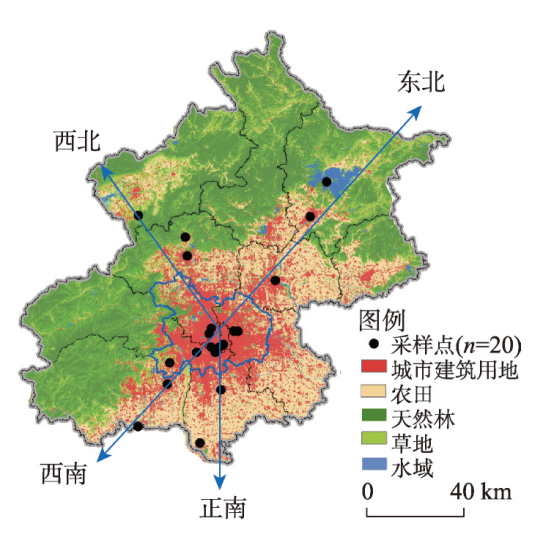

Changes of forest topsoil carbon fractions across urban-rural transects in Beijing
Received date: 2023-07-10
Revised date: 2023-12-22
Online published: 2024-01-29
Supported by
Fundamental Research Funds for the Central Universities(2233200006)
Project of State Key Laboratory of Earth Surface Processes and Resource Ecology(2021-TS-02)
Rapid urbanization has profoundly altered soil carbon cycling and thereby reshaped the spatial pattern of soil carbon content and fractions across the urban-rural gradients. In this study, we measured the contents of total carbon and its different fractions in the topsoil (surface layer 0-10 cm and subsurface layer 10-20 cm) of twenty parks across four urban-rural transects in Beijing, China. We analyzed the spatial variations of different soil carbon fractions and their potential driving factors across the urban-rural gradients. The results showed that topsoil total carbon (topsoil: 21.0±1.6 g/kg; subsurface soil: 18.0±1.3 g/kg) was dominated by organic carbon (topsoil: 64.6%±4.5%; subsurface soil: 54.9%±4.5%). Topsoil contents of organic carbon showed a nonlinear trend from the urban core to the rural area, while the topsoil inorganic carbon content decreased significantly. Topsoil organic carbon (topsoil: 13.8±1.5 g/kg; subsurface soil: 10.0±1.2 g/kg) was dominated by particulate organic carbon (topsoil: 71.3%±2.4%; subsurface soil: 70.5%±2.9%). The contents of both particulate organic carbon and mineral associated organic carbon showed nonlinear changes across the urban-rural forest transects. The proportion of particulate organic carbon was relatively low in urban areas, while that of mineral associated organic carbon showed an opposite trend. Soil texture, soil pH, and park age were important drivers to shape the spatial variation of topsoil carbon components across the urban-rural transects, while the urban-rural climate gradient and species diversity were found to have an unimportant role. Our findings improve the understanding of how urbanization reshapes soil carbon fractions and have useful implications for soil management in urban forests.

TIAN Yuehan , GUO Hongbo , GAO Xiaofei , XIA Nan , DU Enzai . Changes of forest topsoil carbon fractions across urban-rural transects in Beijing[J]. Acta Geographica Sinica, 2024 , 79(1) : 206 -217 . DOI: 10.11821/dlxb202401013
| [1] |
|
| [2] |
|
| [3] |
|
| [4] |
|
| [5] |
[谢天, 侯鹰, 陈卫平, 等. 城市化对土壤生态环境的影响研究进展. 生态学报, 2019, 39(4): 1154-1164.]
|
| [6] |
|
| [7] |
|
| [8] |
[冯晓娟, 王依云, 刘婷, 等. 生物标志物及其在生态系统研究中的应用. 植物生态学报, 2020, 44(4): 384-394.]
|
| [9] |
|
| [10] |
|
| [11] |
|
| [12] |
|
| [13] |
|
| [14] |
[王绍强, 周成虎, 李克让, 等. 中国土壤有机碳库及空间分布特征分析. 地理学报, 2000, 55(5): 533-544.]
|
| [15] |
|
| [16] |
|
| [17] |
|
| [18] |
|
| [19] |
|
| [20] |
|
| [21] |
[张青青, 张桂莲, 伍海兵, 等. 上海市林地土壤有机碳分布特征及其与土壤理化性质的关系. 浙江农林大学学报, 2019, 36(6): 1087-1095.]
|
| [22] |
|
| [23] |
[刘兆云, 章明奎. 城市绿地年龄对土壤有机碳积累的影响. 生态学杂志, 2010, 29(1): 142-145.]
|
| [24] |
|
| [25] |
|
| [26] |
|
| [27] |
[林玉, 聂富育, 杨万勤, 等. 四川盆地西缘4种人工林土壤氮转化酶的季节动态. 应用与环境生物学报, 2019, 25(3): 634-639 ]
|
| [28] |
|
| [29] |
|
| [30] |
|
| [31] |
|
| [32] |
Beijing Municipal Bureau of Statistics. Beijing Statistical Yearbook 2020. Beijing: China Statistics Press, 2021.
[ 北京市统计局. 北京统计年鉴2020. 北京: 中国统计出版社, 2021.]
|
| [33] |
|
| [34] |
|
| [35] |
|
| [36] |
|
| [37] |
|
| [38] |
|
| [39] |
|
| [40] |
|
| [41] |
|
| [42] |
|
| [43] |
|
| [44] |
|
| [45] |
|
| [46] |
|
| [47] |
|
| [48] |
|
| [49] |
|
| [50] |
|
| [51] |
|
| [52] |
[王春燕, 何念鹏, 吕瑜良. 中国东部森林土壤有机碳组分的纬度格局及其影响因子. 生态学报, 2016, 36(11): 3176-3188.]
|
| [53] |
|
| [54] |
[王棣, 耿增超, 佘雕, 等. 秦岭典型林分土壤活性有机碳及碳储量垂直分布特征. 应用生态学报, 2014, 25(6): 1569-1577.]
|
| [55] |
[罗达, 史作民, 王卫霞, 等. 南亚热带格木、马尾松幼龄人工纯林及其混交林生态系统碳氮储量. 生态学报, 2015, 35(18): 6051-6059.]
|
| [56] |
|
| [57] |
|
| [58] |
|
| [59] |
|
| [60] |
|
| [61] |
|
/
| 〈 |
|
〉 |